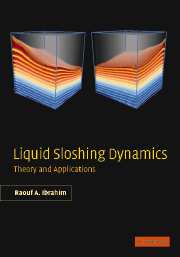Book contents
- Frontmatter
- Contents
- Foreword
- Acknowledgment
- Introduction
- Part I Linear sloshing dynamics
- Part II Nonlinear and parametric sloshing dynamics
- 4 Weakly nonlinear lateral sloshing
- 5 Equivalent mechanical models
- 6 Parametric sloshing: Faraday waves
- 7 Dynamics of liquid sloshing impact
- Part III Sloshing – structure interaction
- Part IV Rotating fluid and low gravity sloshing
- References
- Index
6 - Parametric sloshing: Faraday waves
Faraday waves
from Part II - Nonlinear and parametric sloshing dynamics
Published online by Cambridge University Press: 11 August 2009
- Frontmatter
- Contents
- Foreword
- Acknowledgment
- Introduction
- Part I Linear sloshing dynamics
- Part II Nonlinear and parametric sloshing dynamics
- 4 Weakly nonlinear lateral sloshing
- 5 Equivalent mechanical models
- 6 Parametric sloshing: Faraday waves
- 7 Dynamics of liquid sloshing impact
- Part III Sloshing – structure interaction
- Part IV Rotating fluid and low gravity sloshing
- References
- Index
Summary
Introduction
Parametric sloshing refers to the motion of the liquid free surface due to an excitation perpendicular to the plane of the undisturbed free surface. Generally, parametric oscillation occurs in dynamical\ systems as a result of time-dependent variation of such parameters as inertia, damping, or stiffness. This variation may be due to the influence of externally applied forces or acceleration fields referred to as parametric excitations. For the case of parametric sloshing, the effective gravitational field becomes time dependent. Although parametric oscillation is regarded to be of a secondary interest, it can have catastrophic effects on mechanical systems near critical regions of parametric instability. For example, sloshing waves are generated when the liquid container is vertically excited at a frequency close to twice the natural frequency of the free surface. This type is referred to as Faraday waves since he (1831) was the first to observe and report them. Faraday waves are distinct from other waves with crests normal to a moving boundary (wave-maker) as cross-waves reported by Miles (1985a, 1988b, 1990a), Miles and Becker (1988), and Guthar and Wu (1991), see also Section 4.4. Hocking (1976, 1977, 1987b) observed surface waves produced by a vertically oscillating plate.
In 1831, Faraday observed the fluid inside a glass container oscillates at one-half of the vertical excitation frequency. Another similar series of experiments conducted by Mathiessen (1868, 1970) showed that the fluid oscillations are synchronous.
- Type
- Chapter
- Information
- Liquid Sloshing DynamicsTheory and Applications, pp. 338 - 404Publisher: Cambridge University PressPrint publication year: 2005
- 1
- Cited by



